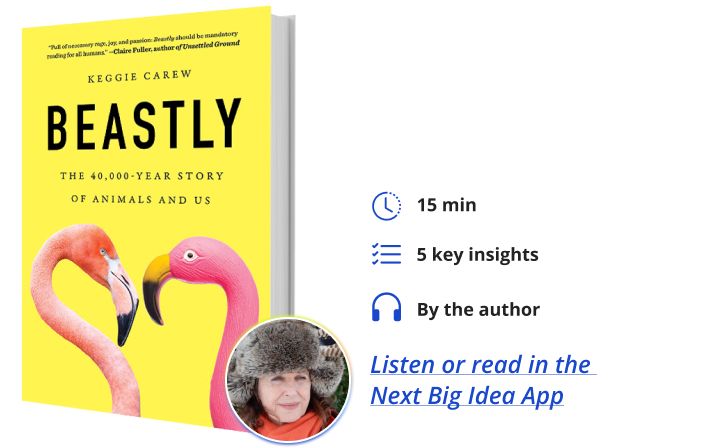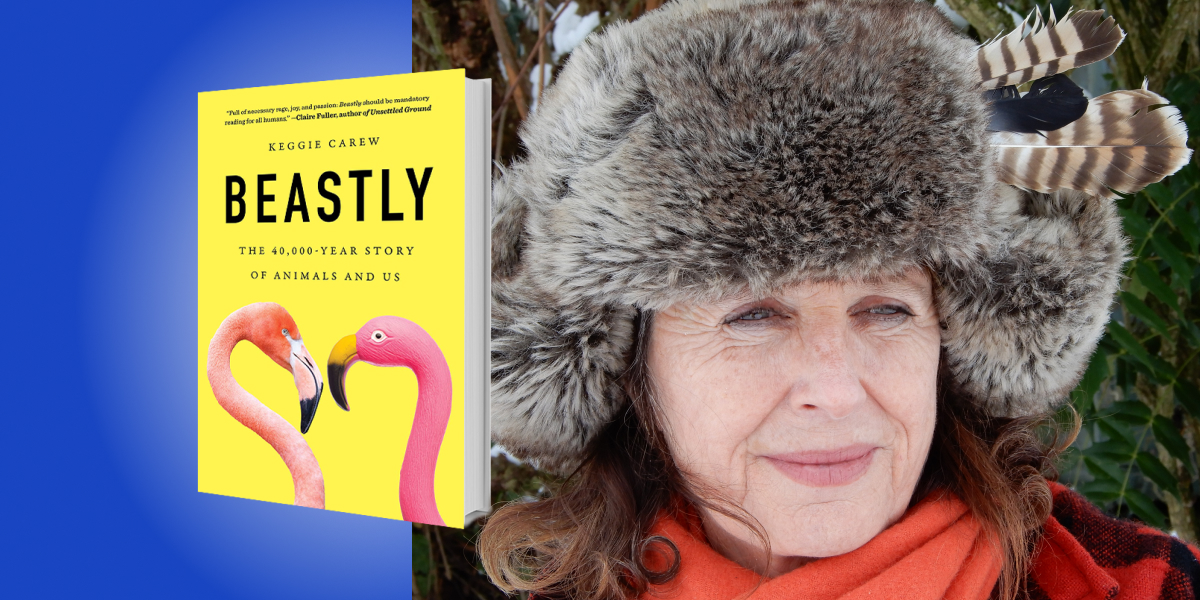Keggie Carew is an award-winning author and ecosystem rehabilitator. Her book, Dadland, won the 2016 Costa Biography Award. She and her husband have rewilded 24 acres at Underhill Wood Nature Reserve in England. There, they offer classes in nature stewardship and opportunities for people of all ages to engage with the outdoors.
Below, Keggie shares 5 key insights from her new book, Beastly: The 40,000-Year Story of Animals and Us. Listen to the audio version—read by Keggie herself—in the Next Big Idea App.

1. Animals are the best environmental fix out there.
Animals maintain the ecosystems that give us oxygen, food, and clean water while taking carbon dioxide away. They replenish the nutrients, engineer the hydrology, build the soil, filter the water, and fertilize both land and sea. Our relationship with them is the most important one on the planet, from the smallest microbe to the largest animal that ever lived. With their presence, ecosystems function. With their absence, they fall apart.
A sperm whale defecates 50 tons of iron each year in the upper layer of the ocean, which fertilizes phytoplankton that capture as much carbon dioxide as terrestrial plants, provide half our oxygen, and feed the krill who feed little fish who feed bigger fish. Whales increase marine life. The body of a great whale takes around 33 tons of carbon to the ocean bed, removing it from the atmosphere for centuries. So, what is her ecological impact? Or the impact of her loss? Before whaling, when sperm whale populations were in the millions, their effect would have been phenomenal. Save the whale to save the seas, to save the planet.
Herbivores graze, open glades, aerate the soil, dam rivers, transport seeds, and scatter dung. Predators keep them in check from overgrazing. It has been estimated that thriving populations of nine key groups of animals (sharks, wolves, otters, oxen, wildebeest, fish, bison, elephants, and whales) could facilitate the additional capture of 6.4 gigatons of CO2 each year. This is almost the amount calculated to limit global warming to 1.5 degrees.
Our biggest challenges (climate change, pandemics, fires, floods, deforestation, soil health, insect collapse, pollution) can all be traced back to our relationship with the planet’s other inhabitants. There is no technology at scale that can do what animals have been doing for millennia. Our saviours are all around us.
2. Human culture has shaped, and misshaped, the way we think about animals.
It’s quite a feat to keep our knowledge of the natural world in the Dark Ages century after century while being surrounded by real live animals. Astonishing to think that in 350 BC, Aristotle described the octopus’s special arm with which he hands over a packet of sperm to the female, yet 2,000 years later, in 1607, Edward Topsell’s Historie of 4-footed Beasts divided animals into three categories: wild and tame, edible and inedible, useful and useless.
Various religions drafted animals in as allegories for Good and Evil (mostly evil). The Devil had animal horns, hooves, hair, and an animal tail. Of all the slanders, the wolf came off worst. Wolves crawl around sacred texts, spring off our churches, they will steal your children and then eat your grandmother. The wolf must die, in literature, myth, and reality. It’s hardly a coincidence that the Latin words for whore and female wolf are the same: lupa.
“Language structures our consciousness.”
Humans ordered the natural world into a hierarchy in which we were not a branch on the evolutionary tree but the pinnacle. Thus, we became separated from the interrelated community of which we are part.
The nature of belief is that it is not about facts. Language structures our consciousness. Words project thought—and insult. We can use them to pervert, poison, and play with our minds. We continue to slander animals: bitch, pig, snake in the grass. Or blame them: vermin, scavenger, pest. We might give personality to animals, but never personhood.
The Taliban entering Kabul in August 2021 were reported by news commentators as showing their sheep faces, although it was expected that they would soon show their true nature as wolves. Changing language changes views because language is loaded.
3. Animals are smarter than we think.
For centuries, animals were clueless, without feeling or even consciousness. The problem was that what we observed was not nature, but nature exposed to our method of questioning. Animals do what they need to do to survive. Chimpanzees wipe the floor with us in memory tests, while horses are phenomenal at reading body language.
Kelly the dolphin learnt that whatever size trash she collected from her pool, she was rewarded. Paper cups, cans, and programs all received a fish. Kelly began to find lots of small pieces of paper, for which she was rewarded lots of fish. When the pool was drained for maintenance, a stash of programs was found under a rock. Kelly had her future fish supply banked by multiplying her harvest, then rationing the humans with torn bits. But Kelly was about to hit the big time. One day a gull flew into her pool and drowned; when she presented it to her trainer, she was awarded several fish. So, Kelly saved one of those fish under her rock to lure another gull into the pool, to catch, and get more fish. This involved planning and delayed gratification. She then taught her calf, who taught other calves, and gull-baiting in the aquarium caught on.
“The problem was that what we observed was not nature, but nature exposed to our method of questioning.”
We seem perpetually surprised when animals turn out to be smarter than we thought. Wild animals need their wits about them. Sardine shoals send out scouts to scope for predators. The satin bowerbird decorates his extravagant twig bower with natural pigment made from chewed-up berries that are loaded onto a sponge he has made from plant fiber.
If we knew animals better, we might value them not just for their services to ecosystems, but for the intrinsic value of their individual and mysterious selves.
4. The longest war on the planet has lasted 12,000 years.
Twelve thousand years ago, as the glacial period ended, we settled by rivers and lakes and became farmers. No need to chase after food anymore: corral it into warm living larders. We chose animals who would yield to our control, then selectively bred them for meatiness, woolliness, docility, and pulling power. But now our livestock needed safekeeping. Our enemies were many, from the smallest insects to bigger predators like the Asiatic lions who once roamed the Levant. Here are the seeds of our 12,000-year war against nature. Like any war, as our technology became more sophisticated, our killing capacity increased, and nowhere more than at sea.
If you take, take, take, you don’t get more, more, more. You get a humungous problem. At sea, we decimated the whales, fished out the cod banks, and continue to destroy marine ecosystems. On land, we depleted the soil. By moving to cities, we broke the natural cycle of fertility by removing the crops but not returning the precious human waste (known as night soil) which now polluted waterways, killed fish, and spread disease. For fertilizer, we ground bones from battlefields and catacombs and cleaned out guano deposits, until a German chemist, Fritz Haber, magicked fertilizer out of the air. Soon synthetic nitrate fertilizer (and explosives) was being manufactured on an industrial scale: the detonator for the human population to explode. Chemical fertilizer changed the course of human history, casting the dice of consequence on animal history
“There is more insecticide present in human breast milk than in cow’s milk.”
More people. More crops. More chemicals. A typical arable field can be sprayed up to 25 times in a single growing season. There is more insecticide present in human breast milk than in cow’s milk. Insect populations are in free fall. Chemicals not only kill insects but the billions of organisms critical to maintain healthy soil. The war goes on. Meanwhile, humans and their industrial livestock take up 96 percent of the world’s mammal biomass, leaving just 4 percent for wildlife. The wild world has had to move over, yet it is the wild world that maintains the ecosystems on which we rely.
5. Animals could save us, but only we can save them.
Nature can recover quite quickly when given the chance. A variety of species not only makes the world beautiful, but liveable through an infinite network of interactions. Animals are the maintenance crew. Every species needs other species, who need other species, to survive. Across the globe, projects to restore ecosystems and connectivity are multiplying. Beavers, bison, otters, whales, and many other animals are making a comeback.
In Chile, a network of smart acoustic buoys monitors the locations of whales and provides shipping with alternative routes. In the Galapagos in 1960, the Espanola giant tortoise (once in their thousands) was down to just 15 individuals due to the vast numbers of feral goats which had destroyed their habitat. After the goats were eradicated, and after a successful 55-year breeding program with those last 15 tortoises brought into captivity, there is now a wild population of more than 2,300. In 2020 the original 15 adults who saved their species from extinction were all returned to their home island, by tractor-trailer, then boat, then backpacked like colossal Stone Age coracles by 15 humans to the interior, to join their large family and live out their long lives. We are the gods.
To save our home, first we have to save theirs.
To listen to the audio version read by author Keggie Carew, download the Next Big Idea App today:































